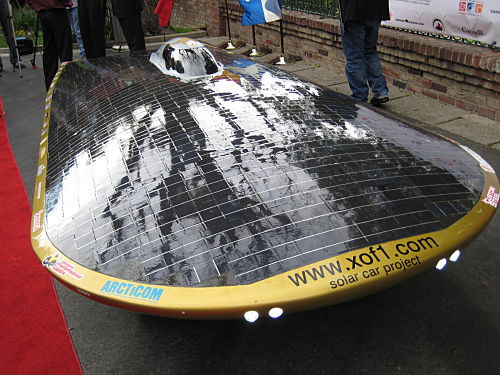The Power Of Sun

Marcelo da Luz's record-breaking trip began in Buffalo, N.Y., in June 2008, and took him through Canada, Alaska and down the West Coast to Los Angeles' Canadian Consulate, where he and his solar-powered car made a pit stop Friday.
"Hopefully this won't be the end of the journey for me," said da Luz, 40, whose UFO-like car broke the world's 9,000-mile distance record for travel by a solar vehicle. His journey came to a halt on Friday, however, because the funding for his project ran out.
"I have no money, no girlfriend. I have a cat and a solar car," da Luz said when he tried to solicit financial support from members of Canadians Abroad and the Canada-California Business Council at the Canadian consulate in Los Angeles.
Accompanied by a support crew traveling in a van, da Luz took the XOF1 car through the Arctic Circle and across the Continental Divide eight times. They stopped in various cities, either by request or because there was no sunlight to power the vehicle. The team traveled more than 11,500 miles to break the previous record.
"It was an incredible challenge," he said.
XOF1= "The Power of One"
A 1987 news clip about the World Solar Challenge race inspired the Brazilian-born Canadian to design XOF1, which he calls The Power of One. It took da Luz 12 years to begin the project.
"Everything we do in life is based on two things: pain and pleasure," da Luz said. "The pain of not following the dream became unbearable."
The 470-pound, 14-foot vehicle took 10 years and more than 50,000 man hours to build, da Luz said. He translates those hours into roughly $50 million based on labor alone but estimates the actual cost at about $50,000.
XOF1 uses 893 mono-crystalline solar cells covering the car's surface area to convert sunlight into electricity that is then stored in 66 pounds of battery. It takes about 900 watts to power the electric motor, and the car can go from 0 to 50 mph in six seconds, reaching a top speed of 75 mph. On a fully charged battery, which does not need to be plugged in, da Luz said, XOF1 can travel 300 miles in the daylight and 130 miles at night.
"For less energy, he can get his car going faster than a toaster can get a piece of toast going," said Canadian Consul General David Fransen.
But da Luz is not a scientist or an engineer. The consuming project forced him to teach himself, leave his job as a flight attendant and re-mortgage his house as he looked for sponsors to fund his work.
Fransen believes that da Luz was able to produce XOF1 "by virtue of individual inspiration and blood, sweat and...personal sacrifice," the consul said. "I'm as proud and I'm as humbled as I can be."
The Power of One vs. the consequence of many
But Fransen and da Luz said they do not think more of these custom-built one-person cars will be manufactured to sell in the suffering global economy or in the United States' ailing automotive industry. They believe the car is a symbol for the fight against climate change.
Manufacturing and selling more of the cars wasn't the purpose, Fransen said. "He built it because he wanted to prove it can be done...it's a symbol of what you can do when you put your mind to it."
However, da Luz said he doesn't advocate the solar car as the answer for human transport needs. "You got to be realistic," he said.
But his journey to the Arctic Circle, where he witnessed the effects of deforestation, illuminated more issues about global warming.
"We're a bunch of hypocrites. We're all waiting for a government, someone or something to save the planet first. It's not going to happen," da Luz said. "And there's all this clean energy we could use today but we lack the political will."
The dream vs. the reality
The concept for a solar car has been around since 1960, da Luz said. "What is practical today is an electric car. And that is the way we should be going."
Paul Scott from Plug in America uses solar panels on his car and house and predicts there will be thousands of solar cars by 2012. "You see the shape of the car...it's not a practical car. But that's what you have to do to make the car with just solar on it viable."
"If this is our future, and I'm hoping it is...it's something that should be supported," said ABC star and guest at the reception Stana Katic. "I think it has a certain feel-good quality that people will be interested in."
But others were still skeptical of XOF1's relevance and marketability.
"It's a good dream, but would it be street legal?" said Tammy Laverty, a member of Canadians Abroad. Laverty said the car reminded her of "The Jetsons" cartoon.
"If it can't get through David Fransen's driveway, it's probably not going to work."
Nonetheless, da Luz attempted to obtain proper financial backing to hire a professional crew and take his message around the world.
"I'd like to do more of this," da Luz said. "I am the Web master, I am the driver, I am the mechanic, the electrician, the designer, the marketing, the PR, and I suck at everything, but somehow I manage to put it together."



